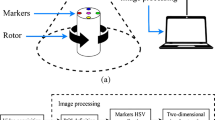Conclusions
-
1.
Instruction No. 166-63 and No. 158-62 must be revised. The procedures discussed in the present article should be considered and the faults indicated above should be eliminated.
-
2.
When checking an AMI in accord with the present instructions it is necessary, in our opinion: to be guided by the standards established in GOST 7164-71 and the technical documentation, or only by the technical documentation if the GOST 7164-71 does not apply (but not the standards given in Instruction No. 166-63 and No. 158-62); to take, when checking for the coincidence of the indicator with the mark being checked, its closest positions to the right and left of this mark. The error and variation must be determined according to the values of the input quantity that correspond to the beginning of the indicator motion away from the position of coincidence when the input quantity is increasing — in the direction of the increase, and when decreasing — in the direction of the decrease. In order to improve the checking efficiency, these values of the input quantity should be determined for each mark checked when approaching it first from one side and then immediately from the other; to check all output devices. If the error of these devices is referred to the AMI'S scale, they must then be checked with due regard for the error of the AMI itself (i.e., as measuring channels). In this case the standardized values of the error and the variation must be increased, respectively, by the permissible values of the error and the variation of the indications.
-
3.
The error of a standard instrument [1, 2, 3] includes the error of all the standard facilities in the checking circuit (for example, when checking the error of the output transducer for the bridge voltage the total error comprises the errors of the resistance box, the connecting leads, and the voltmeter that is used to measure the output transducer's voltage).
-
4.
When checking potentiometers without compensating wires the resistance value of the manganin coil should be chosen in accord with Instruction No. 166-63 for the older designs of potentiometers, but for the KS types where the compensating coil is located outside the instruments — in accord with the technical documentation for these instruments.
Similar content being viewed by others
Literature cited
Instruction No. 158-62. Checking Measuring Instruments by Resistance Thermistors (Bridges and Logometers) [in Russian], Izd. Standartov, Moscow (1969).
Instruction No. 166-63. Checking Automatic Potentiometers [in Russian], Izd. Standartov, Moscow (1971).
GOST 7164-71. Potentiometers and Automatic Balancing Bridges GSP. General Technical Conditions [in Russian].
A. I. Lisenkov, Izmeritel'. Tekh., No. 8 (1973).
F. S. Pinskii and E. G. Shirova, Izmeritel'. Tekh., No. 5 (1973).
M. A. Zemel'man et al. Izmeritel'. Tekh., No. 4 (1972).
Additional information
Translated from Izmeritel'naya Tekhnika, No. 1, pp. 20–23, January, 1975.
Rights and permissions
About this article
Cite this article
Lisenkov, A.I. Method of checking automatic measuring instruments. Meas Tech 18, 33–37 (1975). https://doi.org/10.1007/BF01121724
Issue Date:
DOI: https://doi.org/10.1007/BF01121724




